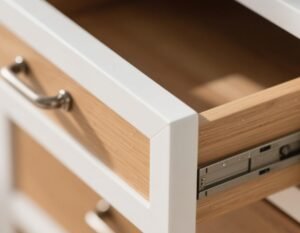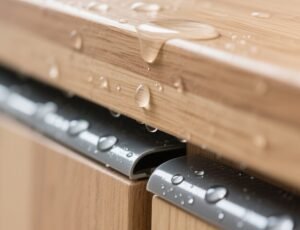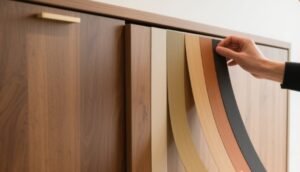Laser edge banding looks amazing. But only if you choose the right material. Get it wrong, and your seamless look can turn into a production nightmare.
The best materials for laser edge banding are ABS, PMMA, PP, and in some cases TPE. Each has strengths and weaknesses in finish, heat resistance, and processing.

If you’re looking for flawless furniture edges without glue lines, laser edge banding is the way to go. But perfect results don’t come from technology alone. They come from the material you pair with it. Let me walk you through how I evaluate and choose the best options.
Understanding Laser Edge Banding Technology and Its Material Requirements?
Most people think laser edge banding is just about machines. But in reality, it all starts with choosing a compatible material.
Laser edge banding uses a focused beam to melt a functional layer on the back of the edge strip. That layer must respond correctly to heat and bond tightly to the board.

Why material choice affects every result
Laser edge banding replaces glue with heat. A laser melts a co-extruded polymer layer, and that layer fuses the band to the panel. When done right, the result is a joint-free edge that resists water, heat, and wear.
But here’s the catch: not all materials melt the same. Some burn. Some bubble. Some don’t bond at all.
Key requirements:
- A thermoplastic functional layer that activates at laser-safe temperatures.
- High surface energy to grab onto the board.
- Stable melt flow for clean lines with no bubbles or shrinkage.
- A finish that matches or enhances the panel’s look.
If the edge material fails at any one of these, the whole product suffers. That’s why I always start with a checklist of thermal behavior, surface finish, and post-bond durability.
Thermoplastic Materials Compatible with Laser Edge Banding: Performance and Processing?
Different materials bring different benefits—and risks. What works for one project might ruin another.
The most common materials used in laser edge banding are ABS, PMMA, PP, and sometimes TPE for soft-touch designs.

Let’s break down how they perform
I’ve worked with all these materials. Each one requires different settings, speeds, and aftercare. If you’re scaling production, even a slight mismatch can lead to waste or callbacks.
1. ABS (Acrylonitrile Butadiene Styrene)
- Easy to process with a wide temperature window
- Good color match, matte or satin finishes
- Durable for everyday use
- Mid-range pricing
2. PMMA (Acrylic)
- Best for ultra-gloss finishes
- Deep color tones, great visual impact
- Brittle under stress and heat
- High processing cost and narrow laser window
3. PP (Polypropylene)
- Eco-friendly and recyclable
- Resistant to moisture and chemicals
- Lower gloss quality, hard to color match
- Sensitive to exact laser calibration
4. TPE/TPU (Thermoplastic Elastomer)
- Soft, flexible feel
- Great for kids’ furniture or curved surfaces
- Expensive and hard to process
- Still in early stages for laser use
| Material | Finish Quality | Durability | Laser Bonding | Cost | Eco Rating |
|---|---|---|---|---|---|
| ABS | ★★★★☆ | ★★★★☆ | ★★★★★ | $$ | ★★☆☆☆ |
| PMMA | ★★★★★ | ★★☆☆☆ | ★★★☆☆ | $$$ | ★☆☆☆☆ |
| PP | ★★★☆☆ | ★★★★☆ | ★★★★☆ | $ | ★★★★★ |
| TPE | ★★☆☆☆ | ★★★☆☆ | ★★☆☆☆ | $$$ | ★★★★☆ |
I use ABS when I need speed and consistency. I use PMMA when the client wants a luxury gloss. PP is best for humid places. And TPE—well, only when the design truly demands it.
Comparative Analysis: Material Behavior Under Laser Processing Conditions?
Materials don’t just melt—they behave in ways that affect final quality. And some behave better than others under a laser.
Each polymer has a different reaction curve to heat. That curve determines whether you get a clean joint or a deformed edge.

Thermal performance is the real challenge
There’s a difference between melting and bonding. I’ve tested materials where the edge melted, but peeled off days later. That’s why I always look beyond the data sheet.
How I test material behavior:
- Pull-shear strength tests to measure bond quality
- UV exposure to check color fading
- Humidity cycling to test for edge swelling
- Heat aging to simulate kitchen cabinet use
| Test Type | ABS | PMMA | PP | TPE |
|---|---|---|---|---|
| Shear Strength | High | Medium | Medium | Low |
| Heat Resistance | Good | Poor | Very Good | Good |
| UV Resistance | Medium | High | Medium | Low |
| Processing Window | Wide | Narrow | Medium | Very Narrow |
PMMA fails most easily under heat but looks best when undisturbed. PP is durable but takes time to dial in. ABS gives reliable performance across board types.
The bottom line? Behavior matters more than the brochure.
Industrial Use Cases: How Leading Furniture Brands Choose Edge Banding Materials?
What works in the lab must also work on the production line. Big brands don’t gamble. They test, verify, and scale what works.
Every brand I’ve worked with has a different edge strategy, based on what they value: speed, looks, sustainability, or cost.

Real brands, real decisions
German kitchen manufacturers
- Go for PMMA on high-end cabinet fronts
- The gloss effect is unmatched, and buyers love it
- But they tolerate higher scrap rates for that visual payoff
European office furniture brands
- Choose ABS for standard desks and storage
- It’s stable, easy to run, and matches modern panel tones
Scandinavian eco brands
- Push for PP, even if it takes longer to process
- Their customers care about recyclability and VOCs
Kids’ furniture producers
- Use TPE to soften impact zones
- Safety beats aesthetics in that segment
| Brand Focus | Material Used | Reason |
|---|---|---|
| High-Gloss Design | PMMA | Visual impact |
| Mass Production | ABS | Efficiency |
| Green Manufacturing | PP | Sustainability |
| Safety Furniture | TPE | Soft edges |
In my own projects, I’ve seen how the right edge can elevate the whole product—and how the wrong one can make even premium boards look unfinished.
Future Trends: Bio-Based and Smart Materials for Laser Edge Banding?
Laser edge banding isn’t done evolving. In fact, the next breakthroughs won’t be in machines—they’ll be in materials.
New edge solutions are being developed that can heal, sense, and even degrade cleanly at end-of-life.

Sustainability and functionality are driving change
Bio-Based Plastics
- PLA and PEF are showing promise
- Still early—most can’t yet survive the heat needed for laser bonding
- But interest is growing, especially in Europe
Recycled ABS and PP
- Already being tested in mass production
- Challenge is consistency—colors vary between batches
Smart Surfaces
- Some edge tapes now include coatings that heal small scratches
- Others are being designed to change color with temperature or touch
| Future Material | Benefit | Limitation |
|---|---|---|
| Bio-PLA | Compostable | Low thermal tolerance |
| Recycled ABS | Lower footprint | Inconsistent appearance |
| Smart Coated ABS | Heals scratches | Expensive |
| Sensor-integrated PP | Interactive edge | Experimental |
In my opinion, the brands that invest in sustainable materials now will be the first to win when regulations tighten and buyers demand traceability.
Conclusion
The best material for laser edge banding depends on your needs. I use ABS for balance, PMMA for luxury, PP for green projects, and TPE when safety matters. Material is the hidden key to a perfect edge.




